Running a business today means finding smarter ways to get more done with less. That’s why so many companies turn to outsourcing—it helps cut costs, boost productivity, and fill skill gaps fast.
Instead of stretching their teams too thin, businesses hand off certain tasks to outside experts and keep their focus on what matters most.
Outsourcing is a key strategy across the globe as organizations of all sizes, from startups to big corporations, rely on it to stay competitive in a fast-moving market.
Today, we’ll share the top outsourcing stats to show you where outsourcing stands in 2025.
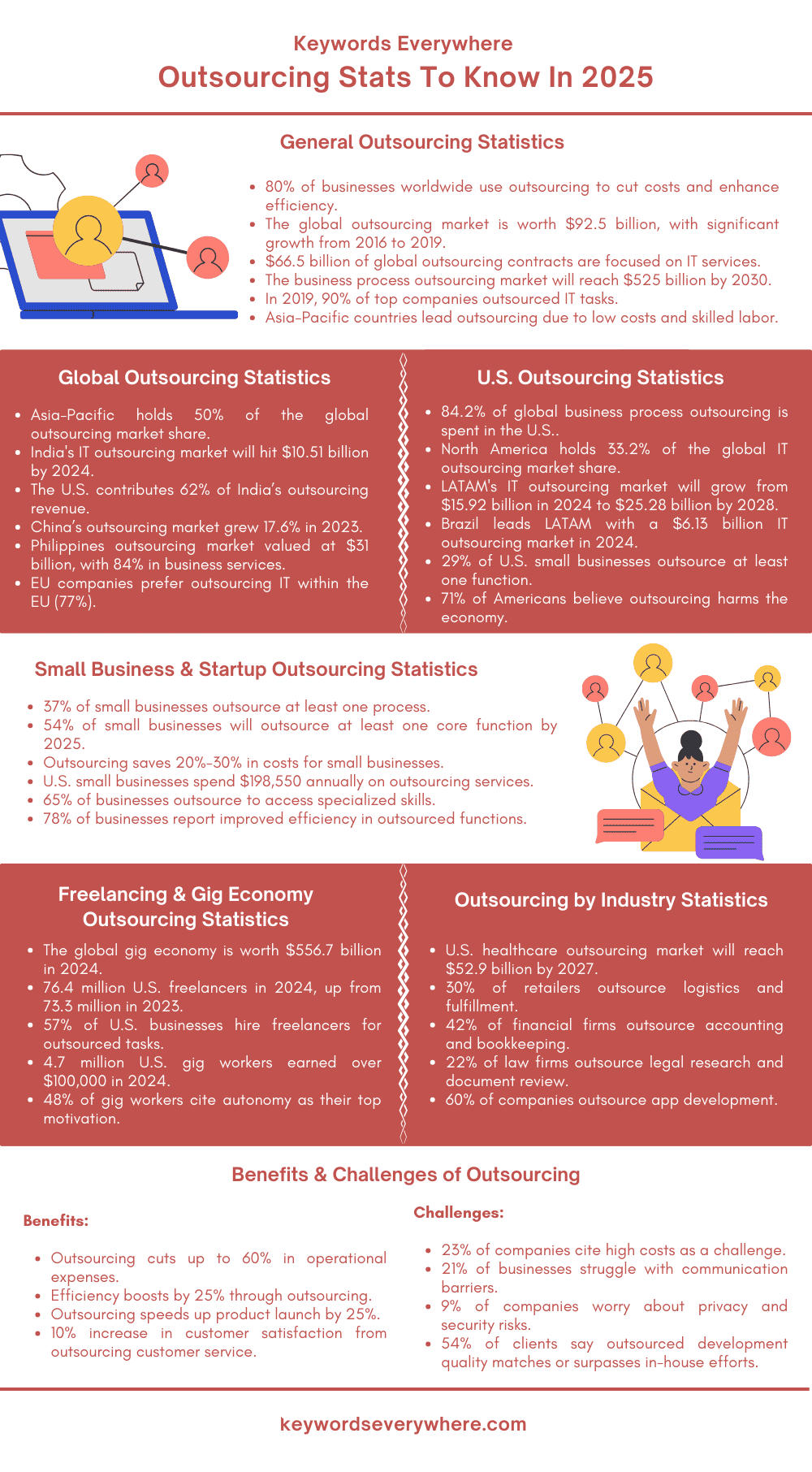
General Outsourcing Statistics
Outsourcing has become a key part of how businesses run today.
Companies are turning to outside help to save money, work faster, and stay focused on what they do best.
This section gives you the most important outsourcing stats that show just how big it has become in 2025—and why it’s not slowing down anytime soon.
1. About 80% of businesses worldwide now use outsourcing to save money, work more efficiently, and tap into expert talent they don’t have in-house.
2. The overall outsourcing market is currently worth $92.5 billion, but it hasn’t always been steady. It peaked at $104.6 billion in 2014, dropped to a low of $76.9 billion in 2016, then bounced back strong with 20% growth from 2016 to 2019.
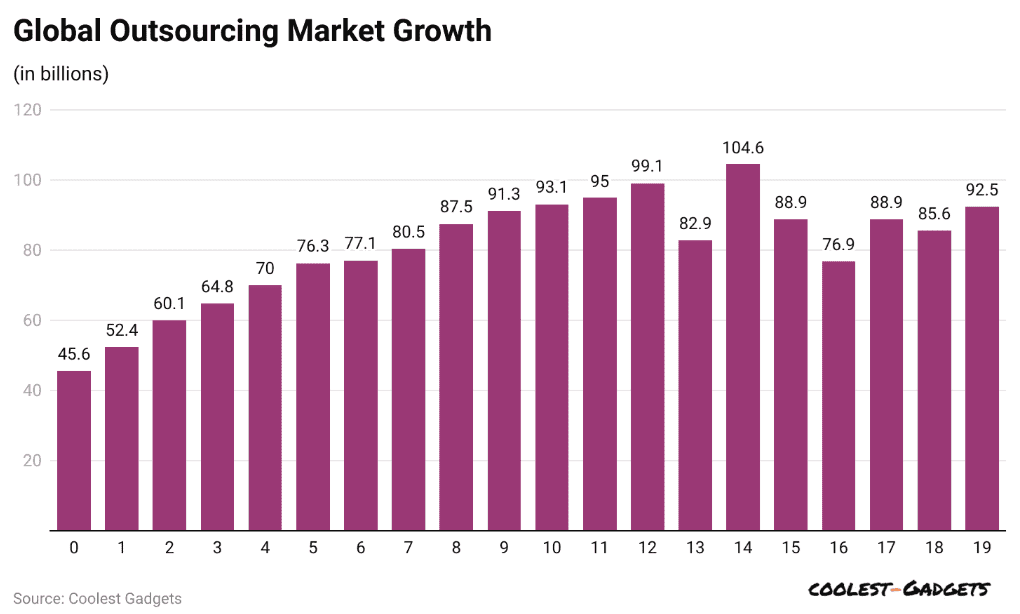
Global outsourcing market growth
3. Outsourcing mostly centers around two key areas—IT services and business operations. Out of the $92.5 billion in global outsourcing contracts, a huge $66.5 billion came from IT services, while the rest—$26 billion—came from business process outsourcing.
4. The business process outsourcing market alone is expected to hit $525 billion by 2030, growing by over 9% every year between now and then.
5. In 2019, over 90% of the world’s top 2000 companies were outsourcing IT tasks. Business process outsourcing wasn’t quite as common, with about 59% of those companies using it.
6. Asia-Pacific countries like India, the Philippines, and China lead the way in outsourcing thanks to low costs, skilled workers who speak English, strong tech systems, and government support.
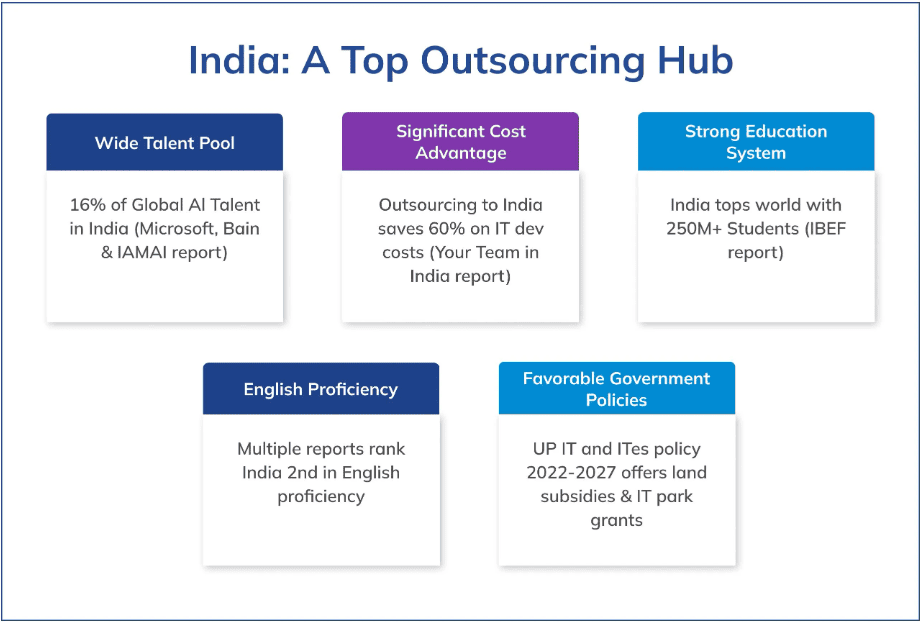
India is the number one outsourcing hub
7. Newer players like Vietnam and Colombia are also growing fast, offering businesses around 20% lower costs compared to traditional outsourcing hotspots.
8. On average, companies save between 15% and 30% by outsourcing, which explains why it’s become a popular choice across industries.
9. According to Keywords Everywhere, interest in outsourcing jobs is strong—each month, more than 8,000 people around the world search online for outsourcing-related job opportunities.
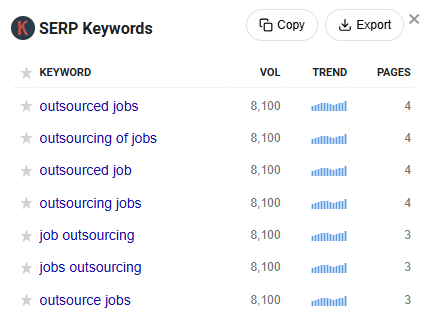
Global Outsourcing Statistics
Across the world, businesses of all sizes are using outsourcing to stay competitive. From IT support to customer service, companies are hiring global partners to cut costs and increase efficiency.
These outsourcing stats share the current size of the global outsourcing market, which countries lead the way, and how worldwide demand is growing year after year.
10. The Asia-Pacific region, including countries like India and the Philippines, holds 50% of the global outsourcing market share, offering skilled labor at competitive rates.
11. India is one of the top outsourcing hubs in the world, and its IT outsourcing market is expected to hit $10.51 billion by the end of 2024. With steady growth at 17.58% each year, it could nearly double and reach $20.09 billion by 2028.

Importers of Indian IT services by country
12. The United States brings in the most money for Indian outsourcing, making up 62% of its revenue. The UK follows with 17%, while Europe contributes 11% and Asia adds another 8%.
13. China’s outsourcing industry grew by 17.6% in 2023, with firms signing outsourcing contracts worth $404 billion.
14. The Philippine outsourcing market is valued at approximately $31 billion, with IT services accounting for 17% and business services for 84%.
15. Between 2018 and 2022, the European IT outsourcing market rose from €13.8 billion to €21.8 billion in contracts per year, reflecting a 12% CAGR.
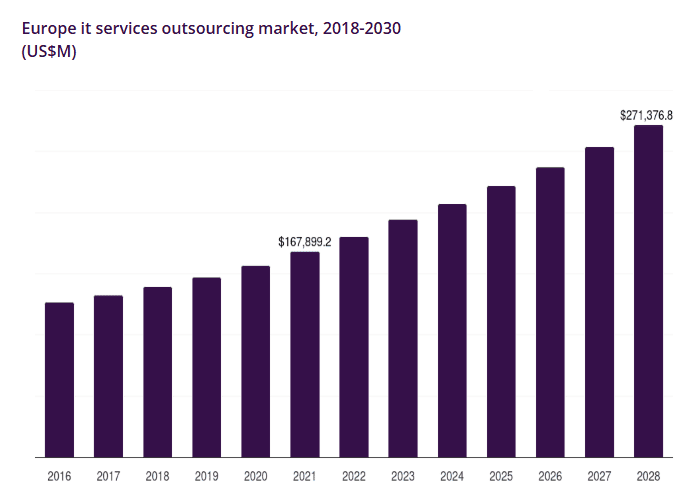
Europe IT services outsourcing market growth
16. In the European Union, 77% of companies that outsource IT choose to keep it within the EU. Others send work to nearby countries (17%), India (17%), the UK (14%), and North America (11%).
17. Outsourcing is a huge part of the Philippine economy—about 9% of the country’s GDP comes from business process outsourcing. Around a million Filipinos work in the industry, which brings in nearly $27 billion a year.
18. Japan’s business process outsourcing market is on track to reach $38 billion by 2025. Even though it’s only growing at about 2.28% a year, the industry still generates trillions of yen in revenue annually.
U.S. Outsourcing Statistics
In the U.S., outsourcing is now a common strategy for both large corporations and small businesses.
Companies are outsourcing everything from accounting to software development to meet customer demands and reduce costs.
These outsourcing stats look at the latest trends in U.S. outsourcing, including which sectors are growing and how American companies are adapting.
19. The U.S. dominates global outsourcing, accounting for 84.2% of the $92.5 billion spent on business process outsourcing around the world. Looking at the bigger picture, North and South America together draw in 42% of all international outsourcing clients.

Business Process Outsourcing by Regions
20. North America continues to dominate the global IT services outsourcing market with a 33.2% share in 2025, owing to a well-established technology infrastructure and a conducive business environment.
21. LATAM’s IT outsourcing market is projected to reach $15.92 billion in 2024, with forecasts suggesting it will grow to $25.28 billion by 2028.
22. Brazil leads the LATAM outsourcing market with an estimated IT outsourcing market size of $6.13 billion in 2024 and a robust CAGR of 12.5%.
23. Mexico holds the title as the 2nd largest IT outsourcing hub in the western hemisphere, with a market size of $5.06 billion in 2024.

IT Outsourcing Mexico
24. In the U.S., outsourcing is far more common among larger companies. About 29% of businesses with 50 or fewer employees outsource any work, but that number jumps to 66% for companies with more than 50 workers.
25. Most Americans aren’t fans of outsourcing—71% believe it hurts the U.S. economy, and 62% think the government should put a stop to it entirely.
26. Between 2001 and 2018, outsourcing to China led to major job losses in the U.S. California was hit the hardest, losing around 654,000 jobs. Texas followed with 335,000, and New York saw 185,100 jobs disappear during that time.
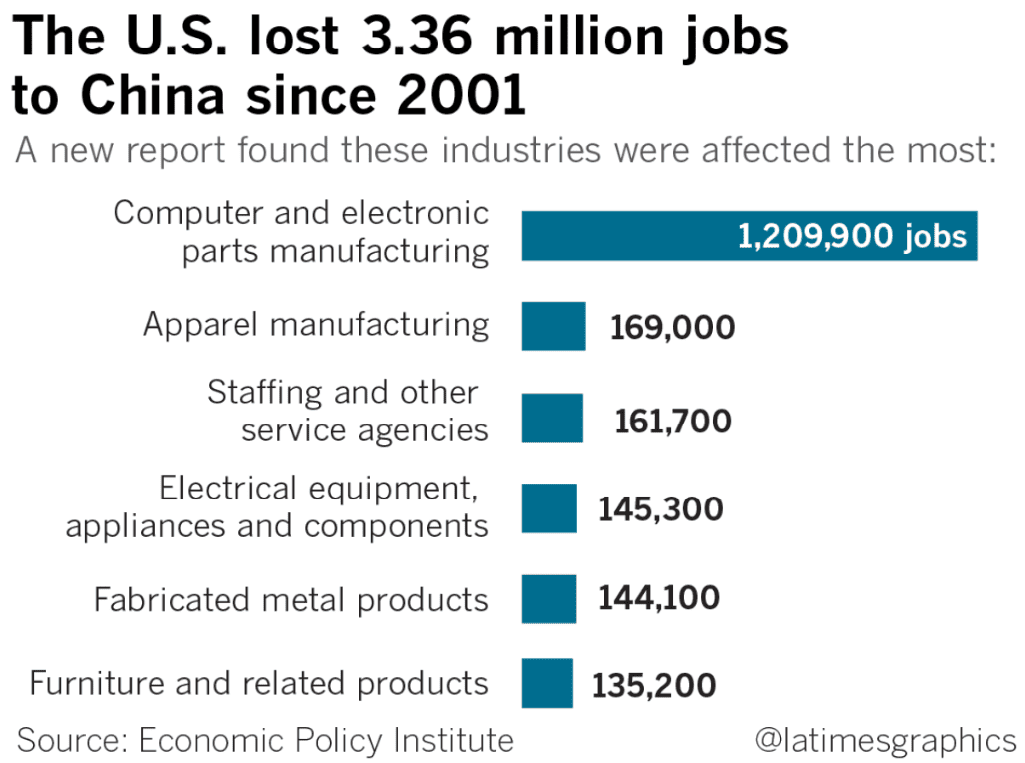
The U.S. faces job loss due to outsourcing
Small Business & Startup Outsourcing Statistics
Startups and small businesses often have limited time, people, and money. That’s why outsourcing has become a powerful tool for growth.
Whether it’s hiring virtual assistants or outsourcing web design, many small businesses are using external help to scale faster.
This section of outsourcing stats shows how outsourcing helps small companies stay lean and move quickly.
27. 37% of small businesses outsource at least one business process, such as accounting, IT services, or digital marketing.
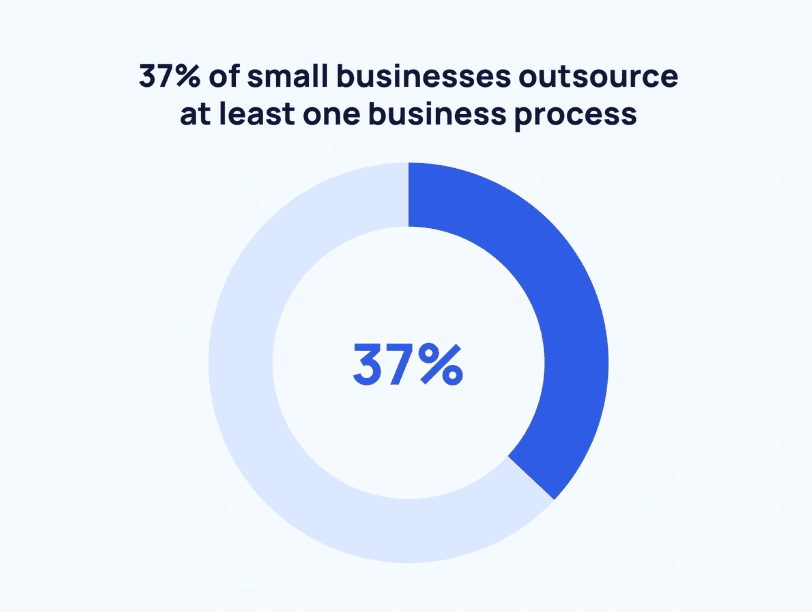
Small businesses outsource a minimum of one business process
28. By 2025, it’s anticipated that 54% of small businesses will outsource at least one core function, reflecting the growing trend of leveraging external expertise for efficiency.
29. Companies that outsource can achieve average cost savings of 20-30%, making it a compelling strategy for small businesses aiming to optimize budgets.
30. On average, a U.S. small business spends approximately $198,550 annually on outsourcing services, highlighting the significant investment in external support.

Average spending on outsourcing by small businesses
31. Approximately 65% of companies outsource to gain access to specialized skills, such as digital marketing, cloud computing, and software development, which may not be available in-house.
32. About 78% of businesses report improvements in their outsourced functions, particularly in areas like payroll services and human resources, due to the efficiency and expertise of outsourcing partners.
Freelancing & Gig Economy Outsourcing Statistics
Freelancers are now a major force in the outsourcing world.
With millions of people working independently, businesses can find talent faster than ever. The gig economy has changed how work gets done, offering flexible and skilled help across industries.
Here are some important outsourcing stats on how freelancing supports outsourcing and what the numbers say about its rise.
33. The global gig economy is valued at approximately $556.7 billion in 2024 and is projected to reach $2.15 trillion by 2033, growing at a CAGR of 16.18%.
34. The number of freelancers in the United States has grown to 76.4 million in 2024, up from 73.3 million in 2023.

Growth of freelancers in the U.S.
35. 57% of U.S. businesses hire freelancers for outsourced tasks, which shows their preference for flexible and project-based outsourcing models.
36. In 2024, 4.7 million independent workers in the U.S. earned over $100,000, a significant increase from 3 million in 2020.
37. Among gig workers, 48% cite autonomy and control as their primary motivation, while 44% aim to balance better career and family needs.
38. Although financial gain is the main reason people choose freelancing, the desire for flexibility and a deeper sense of purpose in their careers are also key motivators. When asked why they freelance, the top reasons were “to earn extra money” (83%) and “to have flexibility in my schedule” (73%).
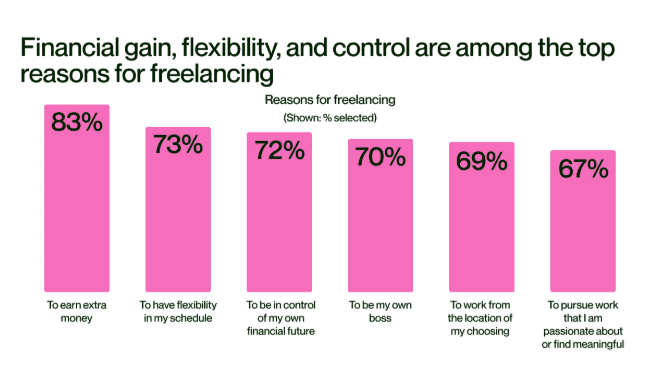
Top reasons for freelancing
39. The gig economy in Britain boasts 4.7 million workers, with 1 in 10 adults participating in gig work. This number has doubled over the past three years.
40. In 2020, the Philippines experienced the highest year-over-year growth rate for freelance revenue at 208%, indicating a rapidly expanding freelance market.
41. As of 2024, gig workers make up about 25% of the global workforce, a significant increase from previous years.
Outsourcing Statistics by Industry
Outsourcing isn’t just for tech anymore, as industries like healthcare, finance, retail, and manufacturing are all using outsourcing to boost productivity and cut costs.
Each industry has its own trends, challenges, and needs. In this section, you’ll see which sectors rely most on outsourcing—and how it’s shaping the way they operate.
42. The U.S. healthcare outsourcing market is projected to reach $52.9 billion by 2027, with 28% of this allocated to medical billing and coding services.
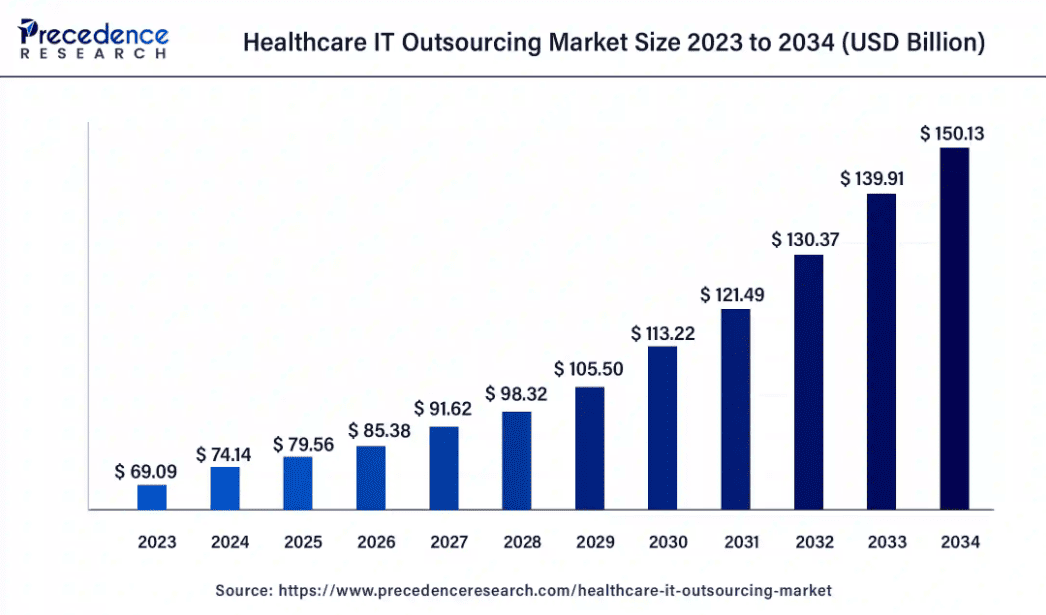
Healthcare IT outsourcing market size
43. Around 30% of retailers outsource logistics and fulfillment to optimize their supply chains and enhance order fulfillment efficiency.
44. 25% of real estate agents outsource property management related tasks, allowing them to concentrate on acquiring clients and closing sales.
45. Accounting and bookkeeping are the top two outsourced functions in the financial services industry, with 42% of firms outsourcing these tasks.

Finance is the top outsourcing service
46. Within the legal sector, 22% of law firms outsource legal research and document review, which are the most frequently outsourced tasks.
47. 60% of organizations outsource app development. It highlights the increasing need for skilled developers and the essential role outsourcing plays in meeting that demand.
Benefits and Challenges of Outsourcing
Outsourcing offers clear benefits: it saves money, speeds up work, and gives access to skilled talent around the world.
However, it also comes with challenges like communication gaps and quality control.
These outsourcing stats break down the most common pros and cons of outsourcing to help you understand both sides of the story.
Benefits of Outsourcing
48. Businesses can achieve significant cost savings through outsourcing, with reports indicating up to a 60% reduction in operational expenses.
49. Outsourcing can increase efficiency by up to 25%, allowing organizations to focus more on core competencies and streamline operations.
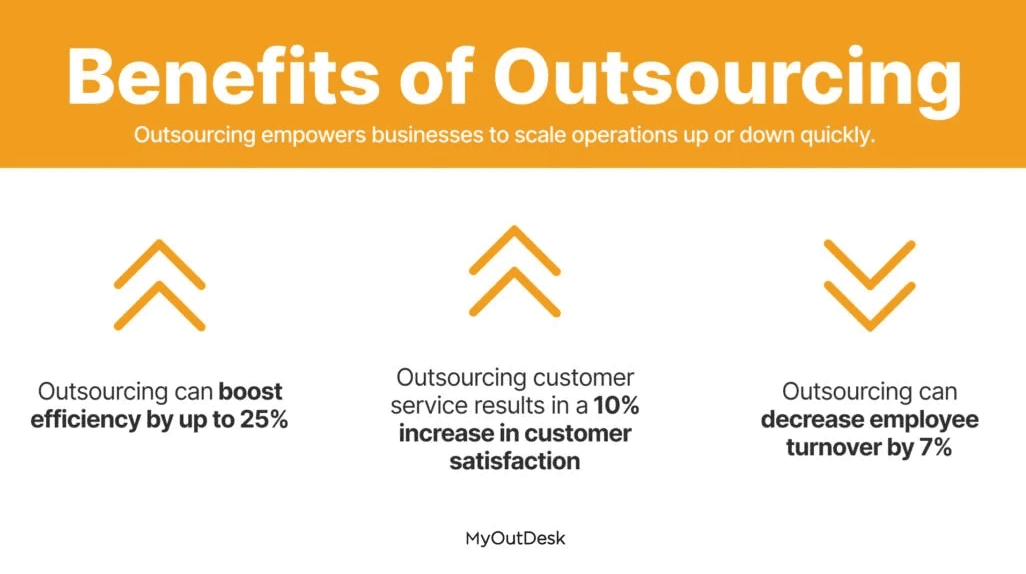
Benefits of outsourcing
50. By outsourcing all the non-critical tasks, businesses can streamline processes and achieve faster product or service launches, with some studies indicating a 25% reduction in time-to-market.
51. Outsourcing customer service roles results in a 10% increase in customer satisfaction, as dedicated teams provide consistent and timely assistance.
52. Outsourcing helps companies redirect their internal resources, leading to an average 12% boost in investment toward innovation and research and development.
Challenges of Outsourcing
53. High costs are the most common challenge companies face with outsourcing, with 23% of respondents saying the price makes it hard to justify.
54. Communication issues are also a major concern, as 21% of businesses report that it’s difficult to interact effectively with outsourced teams.
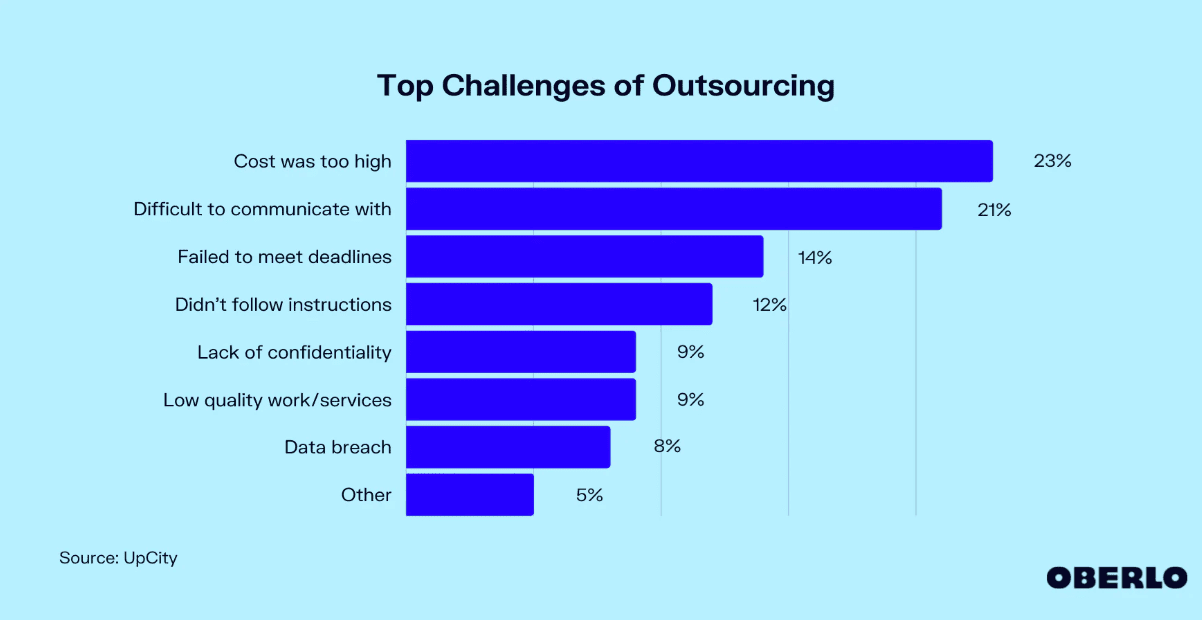
Top challenges of outsourcing
55. Privacy and security risks are another big worry—9% of companies mention concerns over confidentiality, and 8% point to data breaches as a problem they’ve encountered.
56. Only 54% of outsourcing customers report that the quality of development services they get is better or on par with their internal efforts.
57. Forecasts indicate that 60% of finance and accounting outsourcing contracts would not be renewed by 2025 due to outdated pricing models that don’t drive digitization and process improvement.
Conclusion
The numbers say it all: outsourcing has become a must-have strategy for businesses, no matter their size or industry.
It’s not just about cutting costs—it’s a way for companies to boost efficiency, grow, and tap into a global talent pool.
Businesses can free up time and resources to focus on what really matters by outsourcing certain tasks.
In today’s fast-moving world, outsourcing isn’t just an option; it’s become an essential part of staying competitive and thriving.


